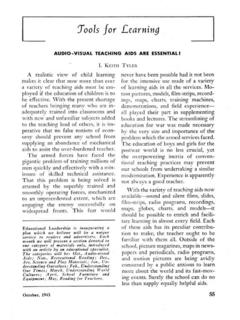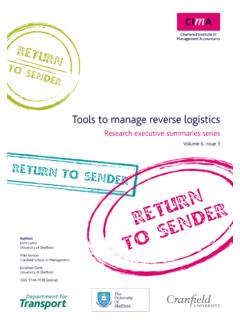Transcription of HIV p36 51 3 - who.int
1 Series36 Prevention 3 Behavioural strategies to reduce HIV transmission: how to make them work betterThomas J Coates, Linda Richter, Carlos CaceresThis paper makes five key points. First is that the aggregate effect of radical and sustained behavioural changes in a sufficient number of individuals potentially at risk is needed for successful reductions in HIV transmission. Second, combination prevention is essential since HIV prevention is neither simple nor simplistic. Reductions in HIV transmission need widespread and sustained efforts, and a mix of communication channels to disseminate messages to motivate people to engage in a range of options to reduce risk.
2 Third, prevention programmes can do better. The effect of behavioural strategies could be increased by aiming for many goals (eg, delay in onset of first intercourse, reduction in number of sexual partners, increases in condom use, etc) that are achieved by use of multilevel approaches (eg, couples, families, social and sexual networks, institutions, and entire communities) with populations both uninfected and infected with HIV. Fourth, prevention science can do better. Interventions derived from behavioural science have a role in overall HIV-prevention efforts, but they are insufficient when used by themselves to produce substantial and lasting reductions in HIV transmission between individuals or in entire communities.
3 Fifth, we need to get the simple things right. The fundamentals of HIV prevention need to be agreed upon, funded, implemented, measured, and achieved. That, presently, is not the one thought, 25 years ago, that HIV prevention would be as difficult as it has proven to be. Despite efforts, UNAIDS now estimates that 33 million people are living with HIV, and 2 5 million new infections arise every We must do better and the question is how. We have learned that no simplistic or even simple solutions exist for HIV prevention. We need to remain humble as we approach the issue of how to keep the virus from moving from one person to in scaling up antiretroviral treatment in resource-poor countries, the benefits of male circumcision, and the hoped for promise of pre-exposure prophylaxis and microbicides do not render behavioural strategies obsolete.
4 If anything, behavioural strategies need to become more sophisticated, combined with advances in the biomedical field, and scaled up. But that task is not easy. Sexual behaviours and the sharing of injection equipment that cause most HIV infections worldwide occur for many motivations (eg, reproduction, desire, peer pressure, pleasure, physical or psychological dependence, self-esteem, love, access to material goods, obligation, coercion and force, habit, gender roles, custom, and culture). The varieties of sexual expression are infinitely greater than is acknowledged or sanctioned by most societies defined legal and moral systems.
5 Ironically, most societies either openly or clandestinely provide opportunities for varied sexual expression, often within the context of substance use, even if the defined legal and moral systems seem somewhat rigid. Sexual behaviour typically does not occur in public, making it difficult to motivate protection when potential transmission occurs, and making it almost impossible to verify reports of what people say they have or have not done. Substance use to the point of intoxication is not only allowed, but is central to many countries economies, and attempts to control the distribution and sale of illegal substances and especially drugs that are injected have met with little Online August 6, 2008 (08)60886-7 This is the third in a Series of six papers about HIV preventionUCLA Program in Global Health, Division of Infectious Diseases, University of California, Los Angeles, CA, USA (Prof T J Coates PhD).
6 Human Sciences Research Council, Durban, South Africa (Prof L Richter PhD); and Universidad Peruana Cayetano Heredia, Lima, Peru (Prof C Caceres MD)Correspondence to: Prof Thomas J Coates, UCLA Program in Global Health, Division of Infectious Diseases, University of California, 10940 Wilshire Blvd, Suite 1220, Los Angeles, CA 90024, USA messages: Behavioural strategies HIV prevention is neither simple nor simplistic. We must achieve radical behavioural changes both between individuals and across large groups of at-risk people to reduce incidence.
7 Once achieved, it is essential that such changes are sustained Although cognitive-behavioural, persuasive communications, peer education, and diffusion of innovation approaches to change are beneficial within a combination prevention framework, behavioural science can and must do better. Novel theoretical and programmatic approaches are needed to inform new approaches to motivate behavioural change Goals for behavioural strategy involve knowledge, stigma reduction, access to services, delay of onset of first intercourse, decrease in number of partners, increases in condom sales or use, and decreases in sharing of contaminated injection equipment.
8 A multilevel approach that encompasses behavioural strategies must be taken behavioural HIV prevention needs to be integrated with biomedical and structural approaches, and treatment for HIV infection The fundamentals of HIV prevention need to be agreed upon, funded, implemented, measured, and achieved in a comprehensive and sustained manner. Access to HIV prevention information, messages, skills, and technologies is essential and a fundamental human 37 Behavioural change has been responsible for the prevention successes to date. Strategies to modify risk behaviours need to remain a main priority for HIV prevention.
9 We define behavioural strategies as those that attempt to delay onset of first intercourse, decrease the number of sexual partners, increase the number of sexual acts that are protected, provide counselling and testing for HIV, encourage adherence to biomedical strategies preventing HIV transmission, decrease sharing of needles and syringes, and decrease substance use. Behavioural strategies to accomplish these goals can focus on individuals, couples, families, peer groups or networks, institutions, and entire communities. Whereas structural strategies seek to change the context that contributes to vulnerability and risk3 and biomedical interventions block infection or decrease infectiousness,4 behavioural strategies attempt to motivate behavioural change within individuals and social units by use of a range of educational, motivational, peer-group, skills-building approaches.
10 And community normative series of papers on HIV prevention in The Lancet emphasises that highly active HIV prevention5 inevitably must be combination prevention (figure 1).1 Advances in biomedical HIV prevention, as in the case of male circumcision or the potential of antiretroviral therapies for prevention, provide substantial opportunities to re-invigorate behavioural approaches to HIV prevention and challenge us to advance structural approaches so that these advances can get to those who need them the All these prevention approaches contribute to effective HIV prevention within communities.
















